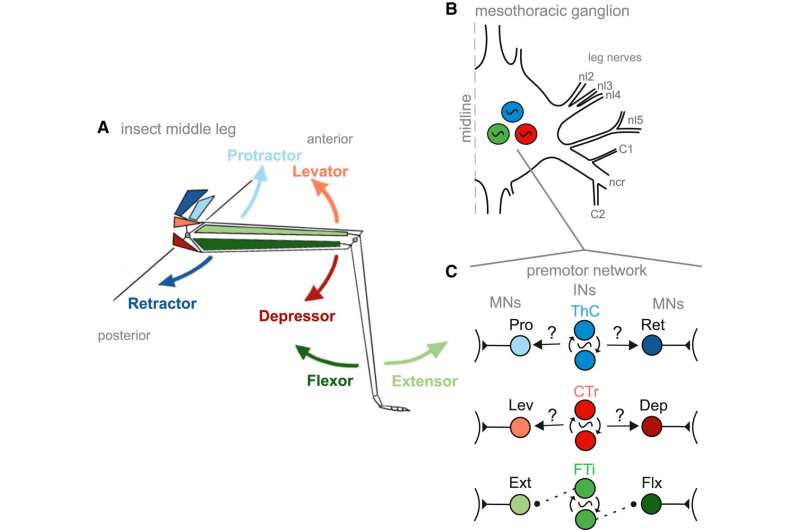This article has been reviewed according to Science X's editorial process and policies. Editors have highlighted the following attributes while ensuring the content's credibility:
fact-checked
peer-reviewed publication
trusted source
proofread
Walking on the move: New insights into the neurology of locomotion

In a new study, scientists from the University of Cologne gained new insights into the mechanism of the rhythmic activation of nerve cells (neurons) in stick insects that control the leg muscles during walking. The researchers showed that the neurons that activate the depressor muscle in the leg are rhythmically excited, unlike those of the other leg muscles. It had been assumed that all of these so-called motor neurons are activated in the same way by central neural networks.
The study, "The synaptic drive of central pattern-generating networks to leg motor neurons of a walking insect is motor neuron pool specific," is published in the journal Current Biology.
The UoC research team investigates the neural foundations of motion generation in animals, in particular those underlying locomotor activities such as walking. For this purpose, the team led by Professor Dr. Ansgar Büschges analyzes insects, as the requirements for the nervous system regarding the generation and control of walking movements are very similar across animal kingdom.
In many animals, for example, there are networks in the central nervous system that form the basis for the generation of rhythmic activity patterns for many forms of movements, whether for rhythmic locomotor activity such as running, swimming, crawling and flying or for vegetative functions such as breathing.
These highly specialized networks are referred to as central pattern generators (CPGs). They generate the rhythmic motor activity of the muscles for movement in interaction with information from sensory organs, neurons called proprioceptors; proprioceptors report movements and inform the central nervous system. In the case of walking, they are located on and in the insect's legs.
The networks do this by activating the so-called motor neurons that innervate the muscles. It had been assumed that such CPGs have the same influence on all motor neurons they target. In their new study, Angelina Ruthe, Dr. Charalampos Mantziaris and Professor Büschges disproved this assumption about the locomotor activity of insects.
In their experiments, the scientists pharmacologically activated the CPGs in the central nervous system of the stick insect Carausius morosus and investigated the influence on the motor neurons that innervate its leg muscles. They found that all motor neuron groups of the leg muscles, except one, receive identical drive from the networks: rhythmic inhibitory signals from the CPGs. Only the motor neurons, which innervate the depressor muscle of the leg, are controlled by phasic excitatory drive.
Interestingly, the leg depressor muscle is precisely the muscle of the insect that is responsible for generating leg stance during any walking situation—regardless of whether the animal runs up or down horizontally, on the ceiling or on a branch. "The rhythmic excitation and thus the specific activation of this motor neuron pool by the CPGs could serve to ensure the exact timing of the contraction of the depressor muscle and thus the start of the stance phase and its stabilization," explained Professor Büschges.
More information: Angelina Ruthe et al, The synaptic drive of central pattern-generating networks to leg motor neurons of a walking insect is motor neuron pool specific, Current Biology (2024). DOI: 10.1016/j.cub.2024.01.026
Journal information: Current Biology
Provided by University of Cologne




















